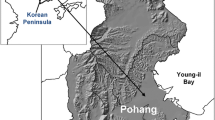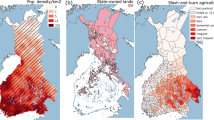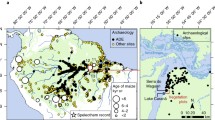Abstract
To understand the legacy of human land use in forest communities, we examined drivers of land use change in three counties of southeastern Ohio. The effects of mineral extraction, agriculture, and patterns of ownership were reconstructed from historical documents and census records over a span of 220 years. In the early nineteenth century, the economy was based on small-plot agriculture, lumbering, and salt extraction for local use and export on the Ohio River. In the mid-late nineteenth century, agriculture profited by integration of non-perishable products into national markets, facilitated by construction of a canal and railroad network. Underground coal mining served national markets between 1880 and 1920, but its effect on regional forests was relatively minor due to its small aboveground footprint and the low market value of the local product. Agricultural abandonment began ca. 1920 in response to regional and national declines in commodity prices, initiating a phase of natural forest regeneration. The most rapid abandonment occurred between 1950 and 1970 corresponding to a nationwide decline in the dairy industry. Since 1970, a shift to offsite employment has decoupled land ownership from commodity markets allowing long-term stability of forest cover. Thus, the biological structure and composition of modern forests are a result of variation in national commodity markets played out in the context of local site quality and accessibility. Due to distinctive social, economic, and environmental factors, the area has not followed the standard narrative of post-industrial Appalachian landscapes.









Similar content being viewed by others
References
Abrams E, Patton P (2015) The ecology of indigenous domestic architecture in the Hocking River Valley, Ohio. In: Redmond B, Genheimer R (eds) Building the past: prehistoric wooden post architecture in the Ohio Valley – Great Lakes. University Press of Florida, Gainesville, pp 63–84
Albright TA, Butler B, Crocker S, Kurtz CM, McWilliams WH, et al. (2018) Ohio forests: 2016. Resource Bulletin NRS-36 Newton Square, PA: U.S. Forest Service, Northern Research Station. 119 pages. https://doi.org/10.2737/FS-RU-139
Beatty EG, Stone MS (1984) Getting to know Athens County. Stone House Publishing, Athens, Ohio
Black D, McKinnish T, Sanders S (2005) The economic impact of the coal boom and bust. The Econ J 115:449–476. https://doi.org/10.1111/j.1468-0297.2005.00996.x
Braun EL (1950) Deciduous forests of eastern North America. Blackburn Press, Caldwell, New Jersey
Brown DG, Johnson KM, Loveland TR, Theobald DM (2005) Rural land-use trends in the conterminous United States, 1950-2000. Ecol Appl 15:1851–1863. https://doi.org/10.1890/03-5220
Bush FW (1905) The Centennial Atlas of Athens County, Ohio, Ohio. University Press, Athens, Ohio
Cao P, Lu C, Yu Z (2018) Historical nitrogen fertilizer use in agricultural ecosystems of the contiguous United States during 1850–2015. Earth Syst Sci Data 10:969–984. https://doi.org/10.5194/essd-10-969-2018
Chapman RA, Wells MA, McGilvray L (1981) Coal resources and sulfur emission regulations: a summary of eight Eastern and Midwestern states. U.S. Environ Protect Agency. EPA 600/7-81-086
Clement F, Amezaga JM (2008) Linking reforestation policies with land use change in northern Vietnam: why local factors matter. Geoforum 39:265–277. https://doi.org/10.1016/j.geoforum.2007.05.008
Compton JE, Boone RD (2000) Agricultural legacies on soil carbon and nitrogen. Ecol 81:2317–2330. https://doi.org/10.1890/0012-9658(2000)081[2314:LTIOAO]2.0.CO;2
Cosgrove B, LaFave D, Dissanayake S, Donihue M (2015) The economic impact of shale gas development: a natural experiment along the New York and Pennsylvania border. Agricultural Resource Econ Rev 44:20–39. https://doi.org/10.22004/ag.econ.207749
Cronon WJ (1991) Nature’s Metropolis. Chicago and the Great West, WW Norton, New York
Crowell DL (1995) History of the coal mining industry in Ohio. Bulletin 72, Ohio Department of Natural Resources, Division of Geological Survey, Columbus, Ohio
Crowell DL (2014) Coal mining and reclamation. GeoFacts No. 15, Ohio Department of Natural Resources, Division of Geological Survey, Columbus, Ohio
Dambrine E, Dupouey J, Laüt L, Humbert L, Thinon M et al. (2007) Present forest biodiversity patterns in France related to former roman agriculture. Ecol 88:1430–1439. https://doi.org/10.1890/05-1314
Darbee JT, Recchie NA (2009) Little cities of black diamonds. Arcadia Publishing, Charleston, South Carolina
de Jong W (2010) Forest rehabilitation and its implications for forest transition theory. Biotropica 42:3–9. https://doi.org/10.1111/J.1744-7429.2009.00568.X
Drummond MA, Loveland TR (2010) Land-use pressure and a transition to forest-cover loss in the Eastern United States. Bio Sci 60:286–298. https://doi.org/10.1525/bio.2010.60.4.7
Dunaway WA (1996) The first American frontier: transition to capitalism in Southern Appalachia, 1700-1860. University of North Carolina Press, Chapel Hill, N.C.
Dupouey JL, Dambrine E, Laffite JD, Moares C (2002) Irreversible impact of past land use on forest soils and biodiversity. Ecol 83:2978–2984. https://doi.org/10.1890/0012-9658(2002)083[2978:IIOPLU]2.0.CO;2
Dyer JM (2001) Using witness trees to assess forest change in southeastern Ohio. Can J For Res 31:1708–1718. https://doi.org/10.1139/x01-111
Elliott J, Frickel S (2015) Urbanization as socioenvironmental succession: the case of hazardous industrial site accumulation 1. Ame J Soc 120:1736–1777. https://doi.org/10.1086/681715
Flinn KM, Marks PL (2004) Land-use history and forest herb diversity in Tompkins County. CAB International. Forest Biodiversity, Lessons from History for Conservation, New York, USA. https://doi.org/10.1079/9780851998022.0081
Foster D, Motzkin G, Slater B (1998) Land-use history as long-term broad-scale disturbance: regional forest dynamics in central New England. Ecosystems 1:96–119. https://doi.org/10.1007/s100219900008
Gallemore C, Munroe D, Van Berkel D. (2018). Rural-to-urban migration and the geography of absentee non-industrial private forest ownership: a case from southeast Ohio. Appl Geogr 96. https://doi.org/10.1016/j.apgeog.2018.05.010.
Goetz SJ (1993) Human capital and rural labor issues. Amer J Agr Econ 75:1164–1168. https://doi.org/10.2307/1243446
Goodwin BK, Grennes TJ, Craig LA (2002) Mechanical refrigeration and the integration of perishable commodity markets. Explor Econ Hist 39:154–182. https://doi.org/10.1006/exeh.2002.0781
Groover MD (2005) The Gibbs farmstead: household archaeology in an internal periphery. Int J Hist Archaeol 9:229–289. https://doi.org/10.1007/s10761-005-9301-6
Hall B, Motzkin G, Foster DR, Syfert M, Burk J (2002) Three hundred years of forest and land-use change in Massachusetts, USA. J Biogeography 29:1319–1335. https://doi.org/10.1046/j.1365-2699.2002.00790.x
Hansen MC (1995) The Scioto Saline—Ohio’s early salt industry, GeoFacts No. 7, Ohio Department of Natural Resources, Division of Geological Survey, Columbus, Ohio
Harris CH (1957) The Harris history, a collection of tales of long ago of southeastern Ohio and adjoining territories. Athens Messenger, Athens, Ohio
Hermy M, Verheyen K (2007) Legacies of the past in the present-day forest biodiversity: a review of past land-use effects on forest plant species composition and diversity. Ecol Res 22:361–371. https://doi.org/10.1007/978-4-431-73238-9_1
HHTA (2022) Hocking Hills Tourism Association. https://www.explorehockinghills.com/. Accessed 12 May 2022
Holmes MA (2020) Pasture trees contribute to structural heterogeneity and plant distributions in post-agricultural forests decades after canopy closure. J Veg Sci 31:454–464. https://doi.org/10.1111/jvs.12873
Holmes MA, Matlack GR (2018) Assembling the forest herb community after abandonment from agriculture: long-term successional dynamics differ with land-use history. J Ecol 106:2121–2131. https://doi.org/10.1111/1365-2745.12970
Hougen KE, Matlack GR (2012) Long-term effects in vegetation and soils at two 19th century iron furnace sites in southeastern Ohio, USA. Forest Ecol Manag 269:279–292. https://doi.org/10.1016/j.foreco.2012.01.001
Hugill P (1982) Good roads and the automobile in the United States 1880-1929. Geograph Rev 72:327–249. https://doi.org/10.2307/214531
Industrial Commission of Ohio (1915) Annual mine report, Dept. of Inspection. Division of Mines, Columbus, Ohio
James A, Aadland D (2011) The curse of natural resources: an empirical investigation of U.S. counties. Resource Energy Econ 33:440–453. https://doi.org/10.1016/j.reseneeco.2010.05.006
Kitchen LC, Marsden TK, Milbourne P (2006) Community forests and regeneration in post-industrial landscapes. Geoforum 37:831–843. https://doi.org/10.1016/j.geoforum.2005.09.008
Law J, McSweeney K (2013) Looking under the canopy: rural smallholders and forest recovery in Appalachian Ohio. Geoforum 44:182–192. https://doi.org/10.1016/j.geoforum.2012.09.008
Luce, R (2012) Images of America: Athens County, Arcadia Publishing, Mount Pleasant, South Carolina
Lucht TE, Brown DL, Martin NH (1985) Soil survey of Athens County. US Department of Agriculture, Soil Conservation Service, Ohio
Mather M (2004) Housing and commuting patterns in Appalachia. Population Reference Bureau, Appalachian Regional Commission, Washington, D.C.
Matlack GR (1997) Four centuries of forest clearance and regeneration in the hinterland of a large city. J Biogeogr 24:297–308. https://doi.org/10.1046/j.1365-2699.1997.00108.x
Mayer A, Olson-Hazboun SK, Malin S (2018) Fracking fortunes: economic well-being and oil and gas development along the urban-rural continuum. Rural Soc 83:532–567. https://doi.org/10.1111/ruso.12198
McGranahan DA (2003) In: Brown DL, Swanson LE (eds) How people make a living in rural America. Challenges for rural America in the twenty-first century. The Pennsylvania State University Press, pp 135–151
McKnight TL, Hess D (2000) Climate zones and types, in Physical geography: a landscape appreciation. Prentice Hall, Upper Saddle River, NJ
Milici RC (1997) The COALPROD database; historical production data for the major coal-producing regions of the conterminous United States. U.S. Geological Survey, Report 97-447- B. https://doi.org/10.3133/ofr97447A
Monsted J, Matlack GR (2021) Shaping the second-growth forest: fine-scale land use change in the Ohio Valley over 120 years. Landscape Ecol 36:3507–3521. https://doi.org/10.1007/s10980-021-01323-6
National Centers for Environmental Information (2022) Athens, Ohio. https://www.ncei.noaa.gov/access/past-weather/athens,%20ohio. Accessed Apr 2022
Ohio Department of Transportation (2019) Historic transportation maps, 1912-2003. http://www.dot.state.oh.us/Divisions/Planning/TechServ/TIM/Pages/OfficialTransportationMaps.aspx. Accessed Apr 2022
Ohio Treasurer's Office (2022) Ohio State properties. https://www.tos.ohio.gov/state-properties. Accessed Apr 2022
Ohio University Office of Institutional Effectiveness (2022) Enrollment history 1860-2022. https://www.ohio.edu/iea/historical-data/general-historical-reports/enrollment-history. Accessed Apr 2022
Oliver CD, Larson BA (1996) Forest stand dynamics. Yale School of Forestry, New Haven, Connecticut
Parker EW (1905) Coal. US Census Bureau special report: mines and quarries. pp. 665–718
Pericak AA, Thomas CJ, Kroodsma DA, Wasson MF, Ross MRV et al (2018) Mapping the yearly extent of surface coal mining in Central Appalachia using Landsat and Google Earth Engine. Plos One 13(7):e0197758. https://doi.org/10.1371/journal.pone.0197758
Perkins VL (1969) Crisis in agriculture: the agricultural adjustment administration and the new deal, 1933. University of California Publications in History, Volume LXXXI. University of California Press, Berkeley and Los Angeles
Peterken GF, Game M (1984) Historical factors affecting the number and distribution of vascular plant species in the woodlands of central Lincolnshire. J Ecol 72:155–182. https://doi.org/10.2307/2260011
Raitz K, Ulack R, Leinbach TR (2005) Appalachia: a regional geography: land, people, and development, Routledge, New York. https://doi.org/10.4324/9780429048302
Redett RB, Parmer ER (1990) Division of Forestry. Pages 70-104 in A Legacy of Stewardship (Charles King, ed.). Ohio Division of Natural Resources, Columbus
Romich E, Bowen N, Civittolo D (2016) Ohio energy trends: Comparing old and new energy development. Ohio State University Extension Service, Fact Sheet CDFS-SED-1
Ross MR, McGlynn BL, Bernhardt ES (2016) Deep impact: effects of mountaintop mining on surface topography, bedrock structure, and downstream waters. Environ Sci Technol 50:2064–2074. https://doi.org/10.1021/acs.est.5b04532
Ruppert LF, editor (2001) 2000 Resource Assessment of Selected Coal Beds and Zones in the Northern and Central Appalachian Basin Coal Regions, U.S. Geological Survey Professional Paper 1625–C
Sandor JA, Gersper PL, Hawley JW (1990) Prehistoric agricultural terraces and soils in the Mimbres area, New Mexico. World Archaeol 22:70–86. https://doi.org/10.1080/00438243.1990.9980130
Sayler KL, Acevedo W, Taylor JL, (2016) Status and trends of land change in the Eastern United States—1973 to 2000: U.S. Geological Survey Professional Paper 1794–D. https://doi.org/10.3133/pp1794D
Schweizer PE, Matlack GR (2014) Factors driving land use change and forest distribution on the outer coastal plain of Mississippi, USA. Landscape Urban Plan 121:55–64. https://doi.org/10.1016/j.landurbplan.2013.09.003
Shumway M, Arnholt D, Knobloch T (2016) Debrosse Memorial Report, Slide 37. “Ohio oil production 1886-2015”. https://marcellusdrilling.com/wp-content/uploads/2017/03/The-Debrosse-Memorial-Report-March-2017.pdf. Accessed Apr 2022
Stoll S (2017) Ramp hollow: the ordeal of Appalachia. Hill and Wang, New York
Stout W (1927) Geology of Vinton County. Geol Surv Ohio, Fourth Ser Bull 51:402
Stover S (1962) Early sheep husbandry in Ohio. Agric Hist 36:101–107
Stubbs GE (2015) Remembering a workplace disaster: different landscapes—different narratives? Masters Thesis. Department of Geography, Kent State University, Kent, Ohio https://etd.ohiolink.edu/apexprod/rws_etd/send_file/send?accession=kent1427661080&disposition=inline
Sturgeon, MT and Associates (1958) The geology and mineral resources of Athens County, Ohio. Bulletin 57. Department of Natural Resources, Division of Geological Survey, Columbus, Ohio
Szabo P (2010) Why history matters in ecology: an interdisciplinary perspective. Environ Conserv 37(4):380–387. https://doi.org/10.1017/S0376892910000718
US Census Bureau (1840a-2010) Decennial Census, US Department of Commerce
US Census Bureau (1840b-2015) Census of Agriculture, US Departments of Commerce and Agriculture
US Department of Agriculture, Economic Research Service. (2019) Rural-urban continuum codes. https://www.ers.usda.gov/data-products/rural-urban-continuum-codes/. Accessed Apr 2022
US Energy Information Administration. (2019) Annual coal reports 1994-2017. https://www.eia.gov/coal/annual/archive/. Accessed Apr 2022
US Forest Service (2015) Reforesting the land. https://www.fs.usda.gov/detailfull/wayne/learning/history-culture/?cid=fsm9_006135&width=full. Accessed Apr 2022
Van Berkel DB, Rayfield B, Martinuzzi S, Lechowicz MJ, White E et al (2018) Recognizing the sparsely settled forest : multi-decade socioecological change dynamics and community exemplars. Landscape Urban Plan 170:177–186. https://doi.org/10.1016/j.landurbplan.2017.10.009
Walker CM (1869) A history of Athens County. Robert Clarke and Co, Ohio
Weinfurtner RC (2002) A landscape history of a pioneer family farm in Athens County, Ohio, Masters Thesis, Department of Geography, Ohio University, Athens, Ohio.
Whitney GG (1987) An ecological history of the Great Lakes forest of Michigan. J Ecol 75:667–684. https://doi.org/10.2307/2260198
Whittaker RH, Niering WA (1975) Vegetation of the Santa Catalina Mountains, Arizona. V. Biomass, production, and diversity along the elevation gradient. Ecol 56(4):771–790. https://doi.org/10.2307/1936291
Williams M (1989) Americans and their Forests, a historical geography. Cambridge University Press
Wymer DA, Abrams E (2003) Early woodland plant use and gardening: evidence from an Adena hamlet in southeastern Ohio. Midcontinental J Archaeol 28:175–194. https://doi.org/10.1016/j.jaa.2017.12.001
Acknowledgements
We are grateful to James Dyer for the map. Timothy Anderson made helpful comments on the manuscript.
Author information
Authors and Affiliations
Corresponding author
Additional information
Communicated by Angus Naylor
Publisher’s note
Springer Nature remains neutral with regard to jurisdictional claims in published maps and institutional affiliations.
Rights and permissions
Springer Nature or its licensor (e.g. a society or other partner) holds exclusive rights to this article under a publishing agreement with the author(s) or other rightsholder(s); author self-archiving of the accepted manuscript version of this article is solely governed by the terms of such publishing agreement and applicable law.
About this article
Cite this article
Monsted, J., Matlack, G.R. Human ecology of forest in an extraction-shaped landscape: Economic and demographic drivers of land use change in the Ohio Valley over 220 years. Reg Environ Change 23, 101 (2023). https://doi.org/10.1007/s10113-023-02094-3
Received:
Accepted:
Published:
DOI: https://doi.org/10.1007/s10113-023-02094-3




